January 4, 2022 – Most reporting agencies took a holiday, creating a backlog in reporting Covid statistics. Unfortunately, Omicron did not follow suit, as reported cases soared. We are beginning to resolve this backlog, and we are gaining insight into the scope of the damage.
Reported cases swelled three-fold in the United States since the start of Christmas week. Actual infections likely dominate reported cases, mainly because of testing supply chain challenges. In modeling from a team of Harvard, Stanford, and Yale University public health scientists, infections outnumber reported cases by eight times at this point. These scientists estimate further that Covid infected 1% of the U.S. population on Sunday alone and 10% of the population in the past three weeks.
At least four states – Alabama, Arkansas, Indiana, and Mississippi – witnessed a tripling in cases last week. Hard-hit Massachusetts, New Jersey, and New York reported a tripling over the past two weeks.

Delays from the Centers for Disease Control in updating hospitalization data keep us from measuring the impact of these surging cases on our already weary health care system. (The CDC promises an update later today.)
Several independent published reports establish Omicron’s mild impact, particularly on hospitalizations and deaths with Covid. However, even a low hospitalization rate will drive patient census higher, given the swelling number of cases.
Pressure from seasonal flu visits exacerbates the strain from Covid admissions. Consistent with prior seasons, these visits surged in recent weeks. Their peak may be weeks away and could double the current rate.
There is encouraging news to report. In a study recently updated by the state of New York, the vaccines remained effective in protecting against infections and hospitalizations. Despite slipping while the Delta variant circulated, vaccination continues to lower the risk of (a breakthrough) infection by 80%. (Early reports hint at a further degradation with Omicron as the dominant variant.)
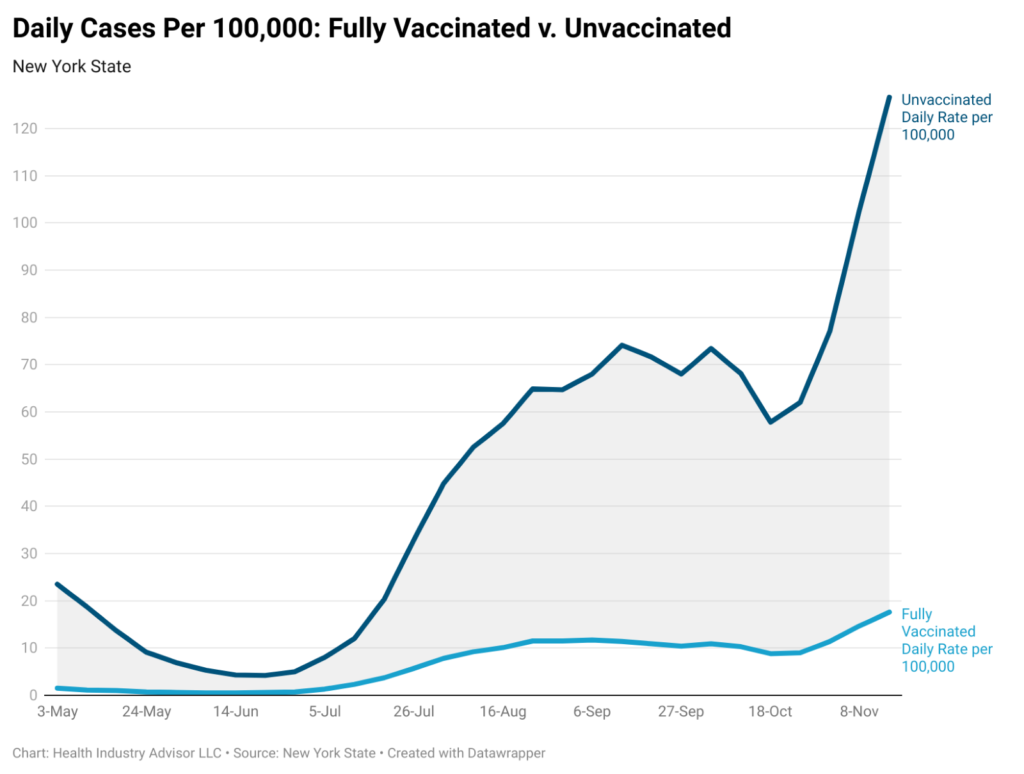
| Rate During the Week of November 15 – 21, 2021 | ||
| Fully Vaccinated | Unvaccinated | |
| Cases | 1 in 5,700 | 1 in 800 |
| Hospitalizations | 1 in 122,000 | 1 in 10,000 |
Source: calculated from data reported by coronavirus.health.ny.gov

Significantly, vaccine effectiveness in preventing hospitalization has not diminished with either the Delta variant or during the early stages of Omicron circulation. According to the New York data, the vaccines have consistently delivered 95% protection against hospitalization since the vaccination effort began.
Lastly, we need to know how long to expect the Omicron surge to last. Several experts, including Dr. Fauci and the Institute for Health Metrics and Evaluation, predict that cases will peak before the end of January or sooner. South Africa’s experience suggests a rapid surge, quickly followed by an equally rapid decline.
Most reporting agencies took a holiday, creating a backlog in reporting Covid statistics. Unfortunately, Omicron did not follow suit, as reported cases soared. We are beginning to resolve this backlog, and we are gaining insight into the scope of the damage.
Reported cases swelled three-fold in the United States since the start of Christmas week. Actual infections likely dominate reported cases, mainly because of testing supply chain challenges. In modeling from a team of Harvard, Stanford, and Yale University public health scientists, infections outnumber reported cases by eight times at this point. These scientists estimate further that Covid infected 1% of the U.S. population on Sunday alone and 10% of the population in the past three weeks.
At least four states – Alabama, Arkansas, Indiana, and Mississippi – witnessed a tripling in cases last week. Hard-hit Massachusetts, New Jersey, and New York reported a tripling over the past two weeks.

Delays from the Centers for Disease Control in updating hospitalization data keep us from measuring the impact of these surging cases on our already weary health care system. (The CDC promises an update later today.)
Several independent published reports establish Omicron’s mild impact, particularly on hospitalizations and deaths with Covid. However, even a low hospitalization rate will drive patient census higher, given the swelling number of cases.
Pressure from seasonal flu visits exacerbates the strain from Covid admissions. Consistent with prior seasons, these visits surged in recent weeks. Their peak may be weeks away and could double the current rate.
There is encouraging news to report. In a study recently updated by the state of New York, the vaccines remained effective in protecting against infections and hospitalizations. Despite slipping while the Delta variant circulated, vaccination continues to lower the risk of (a breakthrough) infection by 80%. (Early reports hint at a further degradation with Omicron as the dominant variant.)
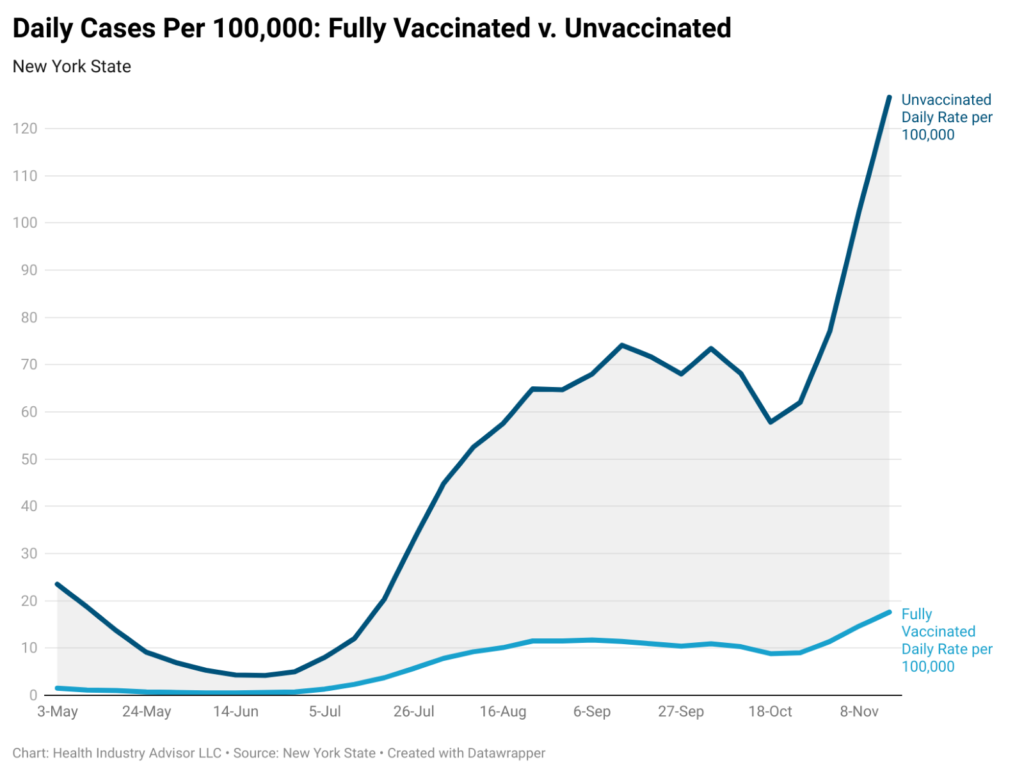
| Rate During the Week of November 15 – 21, 2021 | ||
| Fully Vaccinated | Unvaccinated | |
| Cases | 1 in 5,700 | 1 in 800 |
| Hospitalizations | 1 in 122,000 | 1 in 10,000 |
Source: calculated from data reported by coronavirus.health.ny.gov
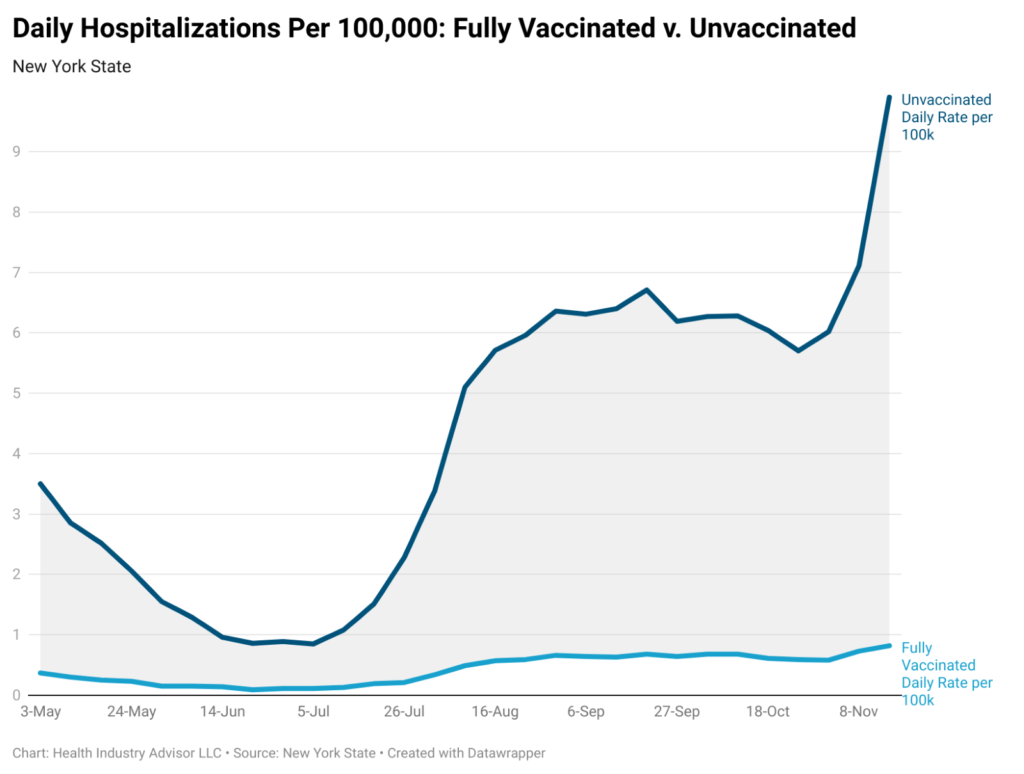
Significantly, vaccine effectiveness in preventing hospitalization has not diminished with either the Delta variant or during the early stages of Omicron circulation. According to the New York data, the vaccines have consistently delivered 95% protection against hospitalization since the vaccination effort began.
Lastly, we need to know how long to expect the Omicron surge to last. Several experts, including Dr. Fauci and the Institute for Health Metrics and Evaluation, predict that cases will peak before the end of January or sooner. South Africa’s experience suggests a rapid surge, quickly followed by an equally rapid decline.
Most reporting agencies took a holiday, creating a backlog in reporting Covid statistics. Unfortunately, Omicron did not follow suit, as reported cases soared. We are beginning to resolve this backlog, and we are gaining insight into the scope of the damage.
Reported cases swelled three-fold in the United States since the start of Christmas week. Actual infections likely dominate reported cases, mainly because of testing supply chain challenges. In modeling from a team of Harvard, Stanford, and Yale University public health scientists, infections outnumber reported cases by eight times at this point. These scientists estimate further that Covid infected 1% of the U.S. population on Sunday alone and 10% of the population in the past three weeks.
At least four states – Alabama, Arkansas, Indiana, and Mississippi – witnessed a tripling in cases last week. Hard-hit Massachusetts, New Jersey, and New York reported a tripling over the past two weeks.

Delays from the Centers for Disease Control in updating hospitalization data keep us from measuring the impact of these surging cases on our already weary health care system. (The CDC promises an update later today.)
Several independent published reports establish Omicron’s mild impact, particularly on hospitalizations and deaths with Covid. However, even a low hospitalization rate will drive patient census higher, given the swelling number of cases.
Pressure from seasonal flu visits exacerbates the strain from Covid admissions. Consistent with prior seasons, these visits surged in recent weeks. Their peak may be weeks away and could double the current rate.
There is encouraging news to report. In a study recently updated by the state of New York, the vaccines remained effective in protecting against infections and hospitalizations. Despite slipping while the Delta variant circulated, vaccination continues to lower the risk of (a breakthrough) infection by 80%. (Early reports hint at a further degradation with Omicron as the dominant variant.)
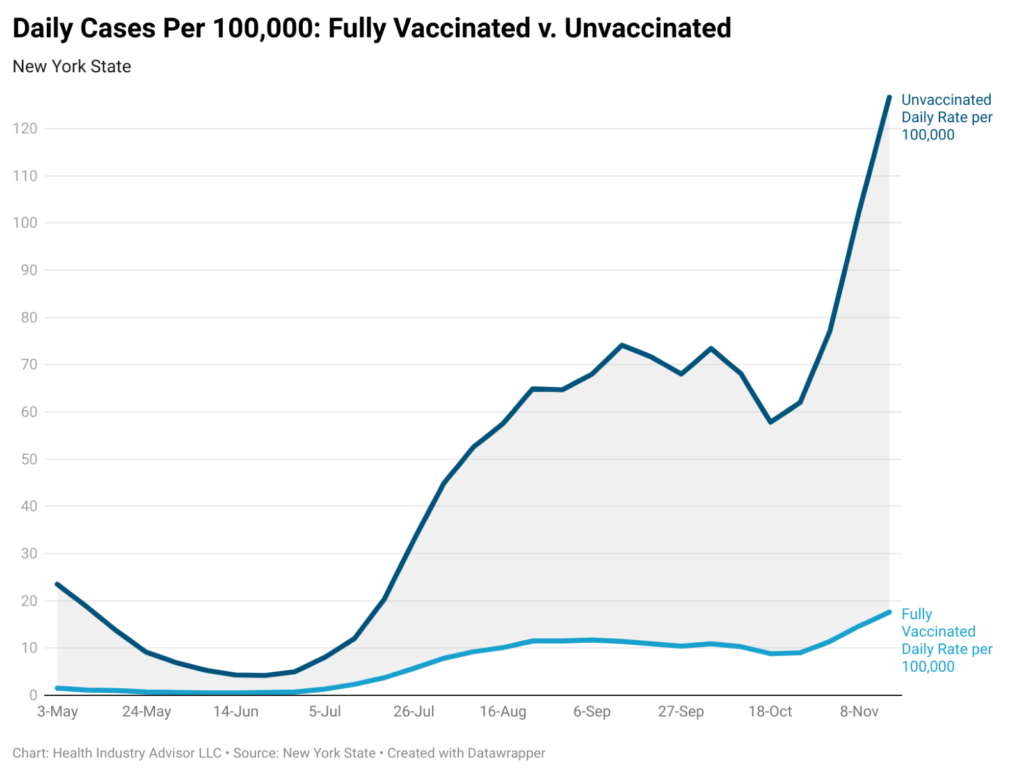
| Rate During the Week of November 15 – 21, 2021 | ||
| Fully Vaccinated | Unvaccinated | |
| Cases | 1 in 5,700 | 1 in 800 |
| Hospitalizations | 1 in 122,000 | 1 in 10,000 |
Source: calculated from data reported by coronavirus.health.ny.gov
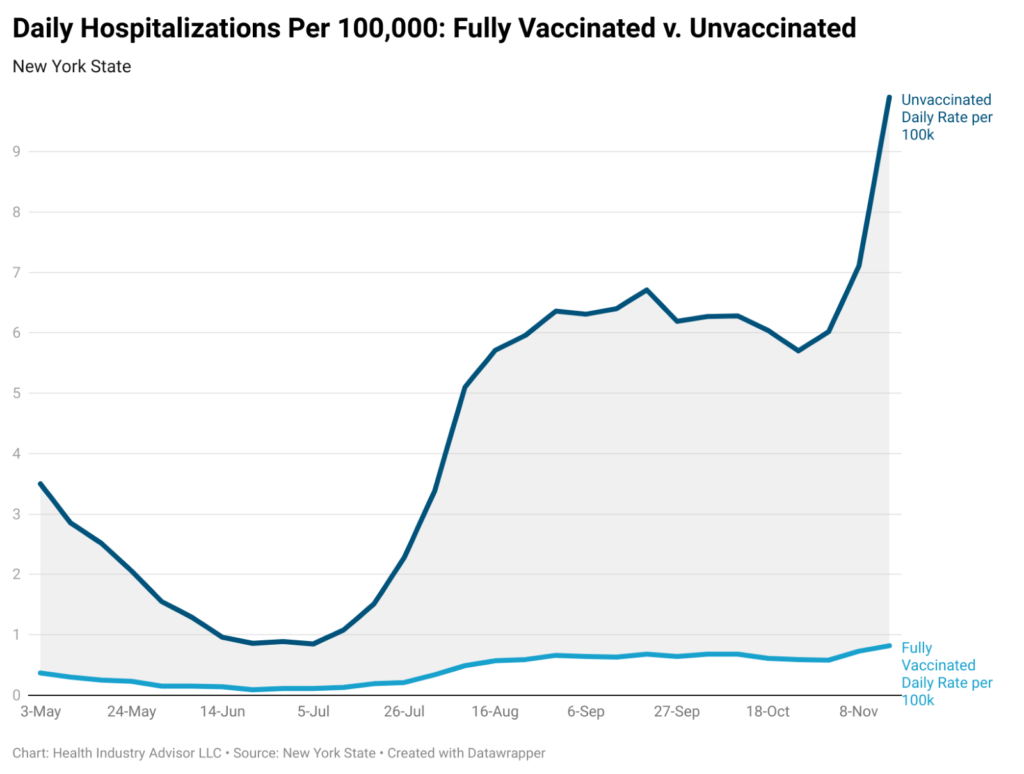
Significantly, vaccine effectiveness in preventing hospitalization has not diminished with either the Delta variant or during the early stages of Omicron circulation. According to the New York data, the vaccines have consistently delivered 95% protection against hospitalization since the vaccination effort began.
Lastly, we need to know how long to expect the Omicron surge to last. Several experts, including Dr. Fauci and the Institute for Health Metrics and Evaluation, predict that cases will peak before the end of January or sooner. South Africa’s experience suggests a rapid surge, quickly followed by an equally rapid decline.
Contributing Writer:
Mark A. Van Sumeren, strategic advisor, Medical Devices & Integrated Delivery Networks
Health Industry Advisor LLC, provides a regular report on COVID-19 numbers for the healthcare industry.
For more information, or to sign up for the report, contact Mark at Mark.VanSumeren@HealthIndustryAdvisor.com or visit www.HealthIndustryAdvisor.com.
